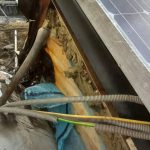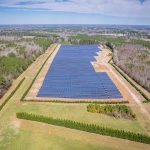If you’ve flown recently, you’ve probably seen the shiny fields of black. If you’re fortunate enough, you probably got an up-close view as you drove by. We are talking about solar farms. Solar farms, also known as solar parks or solar power stations, are large-scale installations that use photovoltaic (PV) panels, commonly referred to as solar panels, or other solar energy collection systems, like concentrating solar systems, to harness the sun’s power. These farms operate as power plants, similar to natural gas power plants or other traditional energy generation sources that have been supplying electricity to consumers for over a century. Solar farms are growing in popularity and can now be found all over the Mid-Atlantic Region. Maryland, Pennsylvania, and Virginia governments are incorporating solar farms into their communities. These farms provide renewable energy to the thousands of homes.
Key Characteristics of Solar Farms
- Scale and Structure
- Large-Scale: Solar farms are significantly larger than rooftop solar systems or commercial solar power systems.
- Ground-Mounted Panels: They typically consist of ground-mounted solar panels spread over extensive areas.
- Decentralization
- Distribution: Unlike residential or commercial solar systems, which provide power to local end-users like homeowners or businesses, solar farms are decentralized.
- Utility Integration: They usually supply power directly to the electric grid, becoming part of the utility’s energy mix.
- Types of Solar Farms
- Utility-Scale Solar Farms: These large projects feed power directly into the grid, serving a broad range of consumers.
- Community Solar Farms: These projects allow multiple community members to benefit from a shared solar power system.
- Dedicated Solar Farms: Some solar farms are built specifically to power large users of solar energy, such as data centers, either onsite or offsite.
Conclusion
Solar farms are essential components of modern energy infrastructure, providing large-scale, renewable electricity to the grid. They differ significantly from residential and commercial solar installations in their scale, structure, and integration with utility services. By contributing to the utility’s energy mix, solar farms play a crucial role in transitioning to sustainable energy solutions.





